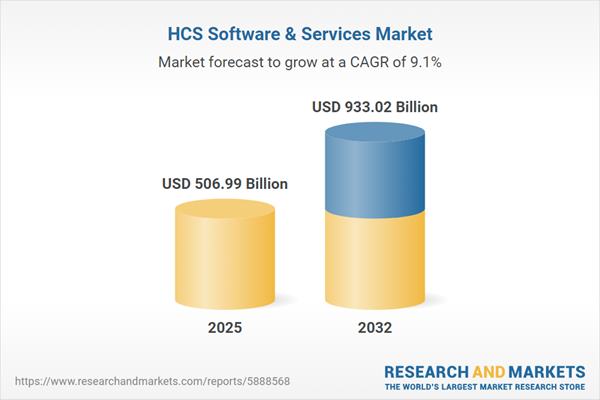Speak directly to the analyst to clarify any post sales queries you may have.
The healthcare software and services market is undergoing rapid transformation, driven by digital innovation, evolving care models, and mounting pressures for operational efficiency. Senior decision-makers must navigate this landscape to capture value, ensure compliance, and realize outcome-based benefits for their organizations.
Market Snapshot: Healthcare Software & Services Market Growth and Outlook
The HCS Software & Services Market grew from USD 465.01 billion in 2024 to USD 506.99 billion in 2025. It is expected to continue growing at a CAGR of 9.09%, reaching USD 933.02 billion by 2032. This global expansion highlights strong demand for digital health technologies, integration platforms, and service excellence across care settings, establishing the sector as a focal point for digital transformation strategies in healthcare.
Scope & Segmentation of the Healthcare Software and Services Market
This report delivers a comprehensive analysis across multiple segments and regions, capturing both technology evolution and changing end-user requirements:
- Component: Services, Support and Maintenance (Adaptive Maintenance, Corrective Maintenance, Preventive Maintenance), Training, Software
- Delivery Model: Perpetual License (Module License, Site License), Subscription (Concurrent User, Named User)
- Deployment Mode: Cloud (PaaS, SaaS), On Premises
- Application Type: Electronic Health Record (EHR), Electronic Medical Record (EMR), Practice Management, Revenue Cycle Management, Telemedicine
- End User: Ambulatory Care Centers, Clinics, Hospitals (Large, Medium, Small), Pharmacy
- Regions: Americas (United States, Canada, Mexico, Brazil, Argentina, Chile, Colombia, Peru), Europe Middle East & Africa (including United Kingdom, Germany, France, Russia, Italy, Spain, Netherlands, Sweden, Poland, Switzerland, UAE, Saudi Arabia, Qatar, Turkey, Israel, South Africa, Nigeria, Egypt, Kenya), Asia-Pacific (China, India, Japan, Australia, South Korea, Indonesia, Thailand, Malaysia, Singapore, Taiwan)
- Key Companies: Siemens Healthineers AG, Koninklijke Philips N.V., General Electric Company, McKesson Corporation, Cerner Corporation, Epic Systems Corporation, Allscripts Healthcare Solutions, Inc., athenahealth, Inc., NextGen Healthcare, Inc., Medical Information Technology, Inc.
Key Takeaways for Senior Decision-Makers
- Integration of cloud-native platforms and AI-driven analytics is enabling streamlined clinical and administrative workflows while supporting proactive patient management.
- Hybrid and subscription-based software models are gaining traction among healthcare providers seeking cost predictability, scalability, and rapid deployment, especially in ambulatory and outpatient settings.
- Strong regulatory dynamics—such as interoperability mandates and data privacy frameworks—necessitate investment in scalable software architectures and resilient service support, with growing emphasis on continuous training and maintenance.
- Shift toward patient-centric and remote care models is driving adoption of telemedicine, remote monitoring, and enhanced patient engagement tools, prompting expansion in both service and software offerings.
- Market players are pursuing modular solutions and strategic alliances, allowing healthcare systems to integrate new capabilities without extensive infrastructure overhaul.
- Regional differences in funding, localization, and compliance influence technology implementation and service partnerships, making a tailored approach essential for effective market entry and growth.
Tariff Impact on Healthcare Software and Services Supply Chains
New United States tariffs in 2025 are causing vendors to reevaluate sourcing and assembly strategies. In response, companies are diversifying manufacturing partners, localizing assembly processes, and investing in adaptive maintenance. These shifts help reduce reliance on imports while supporting timely support, maintenance, and training—even as cost structures evolve. Subscription-based licensing models are gaining importance for mitigating higher upfront costs associated with hardware and imported technology components.
Primary Keyword: Healthcare Software and Services Market
Methodology & Data Sources
This report is grounded in a dual-phase methodology: primary insights obtained from executive and clinical leader interviews; and secondary research comprising regulatory filings, industry publications, and peer-reviewed studies. Quantitative data is validated through triangulation of vendor disclosures, procurement records, and end-user surveys. Forecast models incorporate scenario planning and regional adoption trends, while multiple expert reviews ensure actionable, reliable guidance throughout the analysis.
Why This Report Matters
- Provides actionable segmentation and regional analysis for targeted strategy development and market entry.
- Helps industry leaders evaluate supply chain resilience, licensing models, and technology trends in the evolving healthcare ecosystem.
- Enables executives to benchmark organizational performance and align investments with emerging digital transformation priorities.
Conclusion
As the healthcare software and services market advances, leaders who leverage cloud solutions, modular architectures, and robust partner networks will drive sustainable value. This report empowers organizations with the insights needed for effective strategic planning and competitive resilience.
Additional Product Information:
- Purchase of this report includes 1 year online access with quarterly updates.
- This report can be updated on request. Please contact our Customer Experience team using the Ask a Question widget on our website.
Table of Contents
3. Executive Summary
4. Market Overview
7. Cumulative Impact of Artificial Intelligence 2025
Companies Mentioned
The companies profiled in this HCS Software & Services market report include:- Siemens Healthineers AG
- Koninklijke Philips N.V.
- General Electric Company
- McKesson Corporation
- Cerner Corporation
- Epic Systems Corporation
- Allscripts Healthcare Solutions, Inc.
- athenahealth, Inc.
- NextGen Healthcare, Inc.
- Medical Information Technology, Inc.
Table Information
| Report Attribute | Details |
|---|---|
| No. of Pages | 199 |
| Published | October 2025 |
| Forecast Period | 2025 - 2032 |
| Estimated Market Value ( USD | $ 506.99 Billion |
| Forecasted Market Value ( USD | $ 933.02 Billion |
| Compound Annual Growth Rate | 9.0% |
| Regions Covered | Global |
| No. of Companies Mentioned | 11 |









